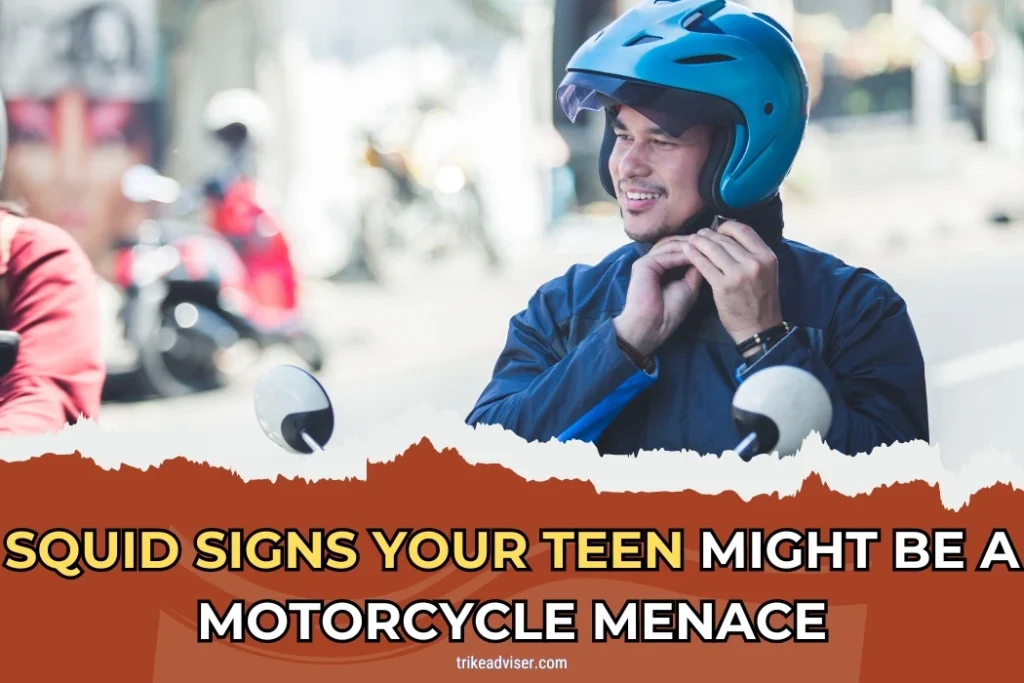Notice your garage smelling faintly of gasoline more often? Your teen might just be tinkering more than you know.
Suddenly, the family car isn’t cool enough for school drop-offs. Is your teen’s new thrill on two wheels? Heads up, parents!
Motorcycle fascination can hit teens hard and fast. It’s like a rite of passage but, let’s be real, it can spiral.
Do they dart out with helmets under their arms? Are late-night revs becoming the norm? These aren’t just pesky habits.
They could be signs your teen is morphing into a motorcycle menace. Before visions of speeding tickets pile up, consider this your wake-up call. Is it rebellion or just a phase? Stick around, and let’s decode these signs together.
9 SQUID Signs Your Teen Might Be a Motorcycle Menace
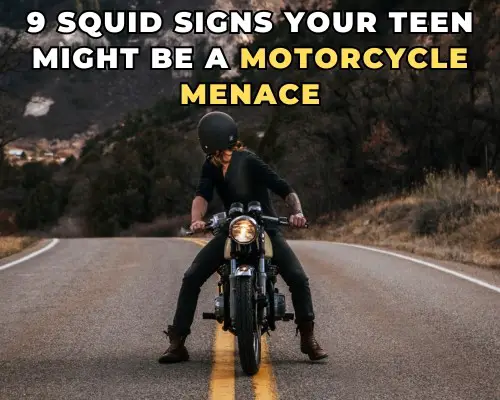
Inexperience
Think your teen’s ready to hit the road just because they’ve driven a car? Here’s the real deal: Biking demands much more than basic road knowledge.
Push for a motorcycle safety course—it’s a game-changer. They’ll learn not just turns and stops but how to handle a bike in surprise situations. Real-life crash scenarios? They cover those too. It’s essential for any rookie rider.
Lower Risk Perception
Invincible? Hardly. Teens often miss the mark on the real dangers of biking. Stats don’t lie—motorcycle riders face a higher risk per mile than car drivers.
Lay it out clearly. Discuss real incidents, and share crash data. Make them see motorcycles require maturity and respect, much more than just thrill-seeking.
Drug or Alcohol Use
Here’s a sobering statistic: Over 25% of motorcyclists killed in crashes tested positive for alcohol. Zero tolerance isn’t just a rule; it’s a lifesaver.
Explain how substances mess with motor skills. Make it real—talk about the lives changed by one poor decision. Set firm ground rules and stick to them.
Distracted Driving
Lost in music or mid-conversation, a moment’s distraction can be fatal. Gear them up with tech that helps, not hinders—think Bluetooth setups for essential calls only.
And prep that playlist in advance. Remind them: When you’re on a bike, the road needs your undivided attention.
Poor Nighttime Driving Ability
Darkness adds a layer of complexity. Even familiar roads look different at night. Limit night rides until they’re more seasoned.
Bright lights and reflective gear aren’t optional; they’re part of the bike. Visibility is safety. Remember, it’s about being seen as much as seeing.
Speeding
Thrills can kill. Speeding leads the stats for teen motorcycle accidents. Explain the mechanics—how speed affects control and increases risk.
Bring in stories of accidents where speed turned minor slips into tragedies. It’s about sensible speeds, not just speed limits.
Lack of Proper Gear
Think a jacket is just about looking the part? Wrong. Over 80% of crashes injure or kill motorcyclists. The right gear is proven armor against the worst.
Show them the gear that saved lives; let them hear from survivors who walked away thanks to a helmet and jacket.
Impaired Riding
Even cold medicine can impair. Riding requires 100% clarity. Review the effects of different substances—including legal drugs—on riding abilities.
Agree on checking in before taking new meds or riding while feeling off. Safety isn’t just about avoiding alcohol; it’s about ensuring they’re always clear-headed.
Peer Influence
Friends don’t always know best. Peer pressure leads to risky rides. Share both sides: tales of teens who rode smart and stayed safe, and those who followed the crowd into accidents. Encourage them to lead, not follow, especially when it comes to safety.
Legal Requirements and Responsibilities
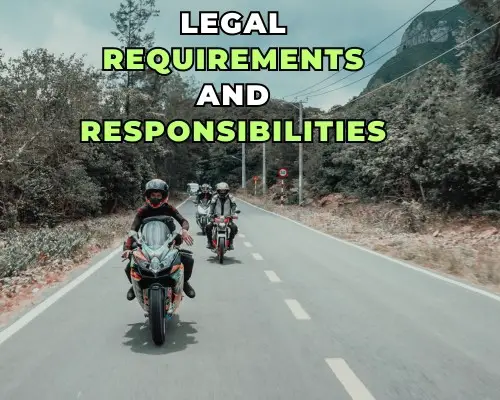
Navigating the maze of motorcycle laws as a teen might seem daunting. Here’s how it’s more than just a hurdle—it’s a cornerstone of safe riding.
Know the Law: Licensing and Legal Requirements for Teen Riders
Securing a license? It’s your gateway to the open road, and it’s wrapped in strict legalities.
- Variable Age Requirements: While 16 is typical for a learner’s permit, some states let eager teens start at 15 with proper training.
Dive into your state’s DMV guidelines to get the exact figures. Understanding these details isn’t just bureaucratic—it’s crucial.
- The Role of Parental Consent: This is far more than a formality. It’s a legal agreement where parents accept to mentor and monitor their teens’ riding. They’re not just signing a paper; they’re committing to your riding journey.
- Document Every Ride: Log your practice hours diligently. This isn’t merely for fulfilling state requirements—it’s a track record of your evolving skills.
Staying Within the Rules: Importance of Compliance with Traffic Laws
Traffic laws aren’t just hoops to jump through—they’re crafted to keep you safe on every ride.
- Helmets and Safety Gear: Mandatory helmet laws are just the start. Your helmet should meet DOT or SNELL standards, which are your assurance of safety, not just compliance.
- Understanding Speed Limits: Speed thrills but also kills. Every increase in speed proportionally increases your risk of an accident.
These limits are there to give you enough time to react safely to road conditions and unexpected hazards.
- Special Motorcycle Regulations: Know your state’s specifics on lane splitting, passenger rules, and more. These laws are tailored to address common scenarios you’ll face on the road.
Riding Smart: Advanced Safety and Compliance Strategies
Going beyond basic legal requirements sets the stage for lifelong safe riding practices.
- Advanced Riding Courses: These courses do more than sharpen your skills. They prepare you for the unexpected and teach crucial survival strategies in high-pressure situations.
- Invest in Premium Gear: High-quality gear might seem costly but consider it an investment in your safety. Look for well-reviewed gear that offers the best protection and visibility.
- Engage Your Parents as Partners: More than just supervisors, your parents can provide wisdom and guidance. Their involvement is a key component of your safety network.
- Consistent Bike Maintenance: Treat your bike maintenance as you would your own health—regularly and meticulously. A bike in top condition is safer, more responsive, and more reliable.
By understanding and respecting these laws and taking proactive steps towards compliance, you not only safeguard your own life but also set a standard for responsible riding.
Every rule you follow, every precaution you take, makes you not just a rider, but a guardian of your own life on the road.
Parental Involvement and Support for Teen Drivers
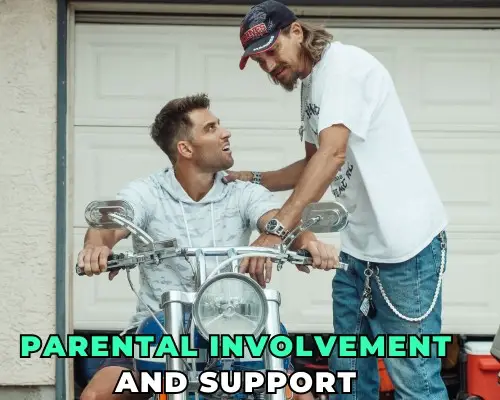
Starting on a ride with a teenage motorcyclist can be like traveling on an exciting but dangerous road.
In addition to enforcing laws, parents must provide their teens with wisdom and foresight as they navigate the complexity of safe riding.
Setting Boundaries and Rules: A Framework for Parents
Just like packing for a big trip, setting rules for motorcycle riding requires careful thought and precision—ensuring everything needed is there, and nothing unnecessary adds weight.
- Define Clear Riding Boundaries: Delineate where and when your teen can ride. Think of it as setting the course on a map, marking out safe paths and danger zones.
For example, limiting riding to daytime hours until they’ve gained enough confidence and skill for more challenging conditions.
- Choose Riding Companions Wisely: Who your teen rides with can influence their habits on the road.
Encourage them to ride with friends who are also trained and serious about safety. It’s like choosing travel buddies who will make the journey safer and more enjoyable.
- Strict Adherence to Traffic Laws: Emphasize the importance of obeying all traffic laws through discussions that link these rules to personal safety stories.
For instance, relate the consequences of ignoring stop signs with real-life incidents that had dire outcomes.
- Mandatory Safety Gear: Enforce a strict policy on safety gear. Take a trip together to pick out high-quality helmets, jackets, and other gear, making it a bonding activity that also sets up safety habits.
Supporting Your Teen’s Passion Safely: Balancing Freedom and Safety
Nurturing your teen’s passion for motorcycling while ensuring their safety can be akin to teaching them to swim—gradual release with constant supervision until they are confident and capable.
- Promote Comprehensive Training: Strongly encourage participation in advanced riding courses. Detail the skills they’ll learn, like emergency braking or swerving, and how these can drastically reduce accident risks. Think of it as equipping them with a life jacket before they dive into deep water.
- Invest in High-Quality Gear: Explain the science behind gear such as abrasion-resistant fabrics and impact-absorbing armor. Show them that good gear is not just a requirement but a lifesaver, much like a seatbelt.
- Set Guidelines for Progressive Riding Freedom: Just as you would gradually increase the depth at which a child is allowed to swim, slowly expand the conditions under which they can ride. Start with local, familiar routes and gradually allow more challenging rides as their skills improve.
- Encourage Physical Fitness: Explain how a strong core and good balance can improve riding skills and reduce fatigue on longer rides. Encourage activities such as yoga or pilates that enhance these physical traits.
Continuous Engagement for Growth
Engaging regularly in your teen’s motorcycling life is essential, akin to attending recitals or sports matches but with higher stakes.
- Regular Discussions on Experiences and Learning: Like debriefing after a trip, talk about what went well on their rides and what could be improved. This can help identify areas where they feel less confident and need more practice.
- Educative Talks on Riding Risks: Talk about the risks associated with riding by using news articles and statistics.
For instance, mention that the risk of death in a motorbike accident is 29 times higher than that of passenger car occupants per mile driven.
- Practice Defensive Riding Together: Occasionally join them on rides or in training sessions. This not only shows your support but also allows you to directly observe their skills and habits.
- Be Present for Licensing Tests: Offer support during road tests and other licensing steps. Your presence can alleviate anxiety and demonstrate your commitment to their interest.
Influences on Teen Riding Behavior
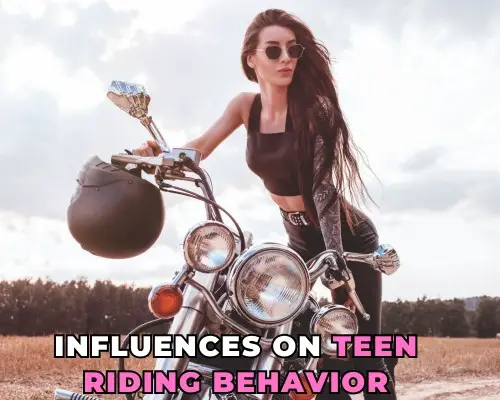
Adolescence is a difficult journey to navigate, made more so when motorbikes are involved. Although there are genuine pleasures, teenage riders may be influenced to engage in risky activity.
Peer Pressure and Riding: Navigating Social Influences
Peer pressure isn’t just about pushing boundaries; it’s about belonging. Teens may mirror risky behaviors to fit in, such as speeding or skipping protective gear.
Understanding the Impact: Teens might adopt risky behaviors under peer influence, thinking it boosts their image. It’s crucial to discuss how group dynamics can lead to unsafe riding decisions.
Creating a Positive Peer Network: Encourage your teen to join clubs or groups that emphasize riding safety.
Positive peer pressure can reinforce good habits just as strongly as negative influences can encourage risky ones.
Role-Playing Responses: Practicing responses to peer pressure can empower your teen. Role-play scenarios where they might feel pressured to conform and discuss ways to handle these situations, reinforcing that it’s okay to stand up for safety.
Highlighting Consequences: Share stories where peer pressure led to accidents or close calls. Real-world examples can effectively highlight the grave repercussions of giving in to peer pressure.
The Impact of Media and Cultural Influences: on Teen Perceptions
Teenagers’ perceptions of safe motorcycle riding may be distorted by the media’s frequent glorification of motorcycles as symbols of liberation and rebellion.
Critical Viewing of Media: Watch films or shows together that feature motorcycles and discuss their portrayal of riding. Highlight the discrepancies between Hollywood dramatization and real-world riding.
Educational Interventions: Introduce documentaries or articles that showcase responsible motorcyclists and the importance of safety gear and proper training.
Understanding the broader context can help teens resist glamorous but unrealistic portrayals.
Debunking Myths: Discuss how media often omits the realities of daily riding, such as dealing with weather, maintaining control in traffic, or the aftermath of not wearing proper gear.
Promoting Responsible Media Figures: Support and encourage interest in motorcycling figures who promote safety and responsibility, showing that respect and admiration can also come from prudent riding practices.
Enhancing Safety Through Awareness and Education
Teens need more than just rules; they need reasons. Understanding why safe riding is crucial can turn passive compliance into active commitment.
Continuous Education: Regular discussions about motorcycle safety, updates on local laws, and changes in riding technology can keep safety at the forefront.
Visibility of Consequences: Sometimes, teens need to see to believe. Arrange visits to traffic safety programs or talks by first responders who’ve seen the consequences of unsafe riding.
Reinforcement Through Rewards: Acknowledge and reward your teen for responsible riding decisions. Positive reinforcement can motivate safer behaviors more effectively than fear of punishment.
Family Riding Days: Organize days where the family goes out riding together, observing all safety protocols.
It’s a fun way to reinforce safe practices and shows that you value both the activity and the safety measures involved.
As an Amazon Associate, I earn from qualifying purchases, at no additional cost to you. Read Our Affiliate Disclosure.

